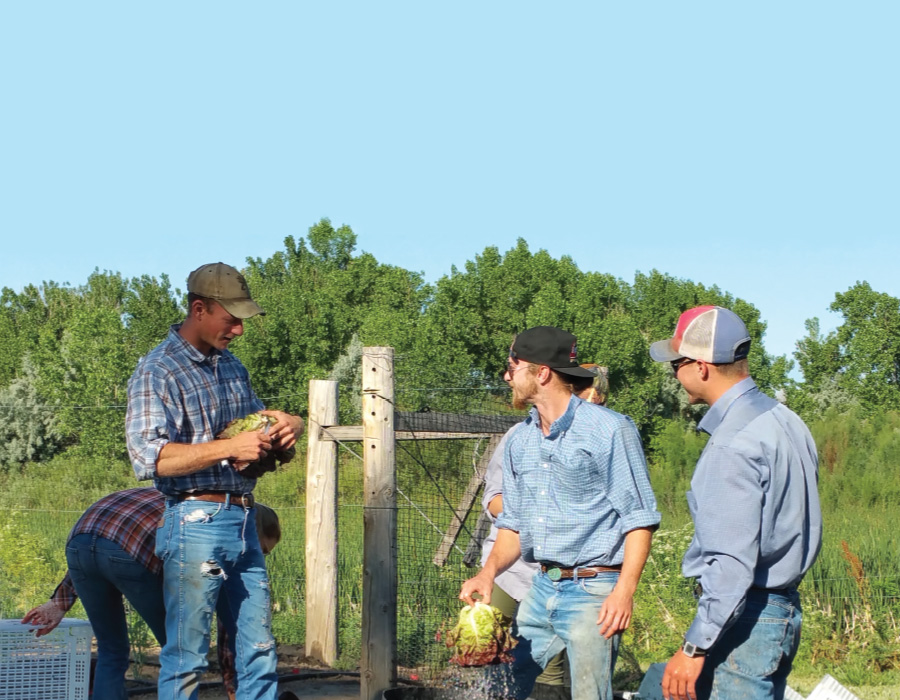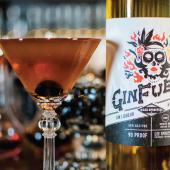Stay Frosty
Are you tired of hothouse tomatoes and prepackaged meats? Do you long to enjoy freshly harvested produce and farm-raised meats right from the source? Look no farther. The Frost family, now in its fourth generation of ranching and farming, takes pride in growing healthy, sustainable foods from vegetables to humanely raised beef and lamb. So come along as we take you to a real working ranch with lasting commitments to the future of agriculture in Colorado.

“Our mission,” says Will Frost, farm manager at Frost Livestock Co., “is to produce quality agricultural products in a way that makes the next year even more productive.”
Low-intensity rotational grazing is a key component. “We move cows and sheep from one field to the next,” says Will’s dad—and Frost Livestock Co.’s president—Jay Frost, “so all the land is receiving an adequate amount of manure to promote better growth for the next year.”
“Another component is what we’re not doing,” says Will’s brother, Sam Frost, who serves as the company’s vice president. “We do not apply synthetic fertilizers, pesticides, and herbicides, so that puts us in a position where the land is regenerating itself in a natural state.”
However, this method of farming has its challenges. “It requires a lot more labor because we can’t just spray something to kill the bugs and the weeds,” Will says. “So we have to harvest our vegetables the old-fashioned way—by hand, by family, and by neighbors.”
“It’s stressing us to operate this way,” Sam says, “but we know when we get our product, it’s clean, tastes good, we know how it was grown, and we can share that message with the consumer.”

For 10 years, the family participated in farmers markets. They enjoyed meeting people, talking about farming, and selling their products, but they realized that there were downsides. With no guaranteed income, they could spend all day and come away with pennies.
There had to be a better way—and they found it. Their fresh produce is now available seasonally through a community supported agriculture (CSA) share. Customers pay a seasonal fee, and every week or biweekly, they pick up a basket brimming with freshly harvested produce from carrots and zucchini to tomatoes and corn, right from the farm—whatever’s ripe and ready that week.
“The beauty of a CSA,” Sam says, “is that it’s guaranteed income. The hardest part of regenerative agriculture is that it exists in a noncontractual realm.” But with a CSA there is a contract between the farmer and the consumer.
“The consumer pays up front,” Will says, “and we know exactly how much we’re going to sell and what we need to harvest.” Julie Frost, a longtime family friend and customer, is a huge supporter. “I get a full share,” she says. “When I drive out to the farm, Jay will be there with the boys. They’ll be chatting, and Jay will reach out, grab a cucumber, and pop it in his mouth.”
Every week, customers can expect to get 15 to 20 pounds of produce. A full share, such as Julie gets, provides enough to feed a family of four. “We’re only two people,” Julie says with a smile, “but I cook a lot and entertain. Sharing local food is, to me, the most important thing in the world. When I drive by McDonalds or look at people’s grocery carts at the supermarket, I’m sad that people don’t understand the connection between local agriculture and community.”
Farm Table
“We can have conversations with our customers about chickens or sheep or the cows in the pasture,” Sam says. “And since they get to meet all of us, they start to feel that they are part of a community.”
The concept of farm-to-table eating has special significance for the Frost family. “It’s about removing the middleman that the restaurant or grocery store provides,” Will says, “so the consumer gets to see and meet the farmer and consume the product that’s being raised or grown on that property.”
“We can have conversations with our customers about chickens or sheep or the cows in the pasture,” Sam says. “And since they get to meet all of us, they start to feel that they are part of a community.”
Sometimes, when customers come to pick up their produce, they’re so excited they ask if Will or Sam offer volunteer opportunities. Will’s answer is always an enthusiastic yes: “If you’re interested in volunteering to learn more about what we do, I’m always game to say come on down for a day or a half day and hoe vegetables or pick vegetables on harvest day.”
Ben Anderson is an electrician and welder by trade. But at 7 a.m. every Saturday morning during the busy summer months, you’ll find him picking vegetables on the farm. “There’s an abundance of good smiles down there,” Anderson says. “It’s a great community vibe.” And, he says, it’s a nice change from the hustle and bustle and honking trucks in the city. “I like getting my hands dirty trying to get the carrots out of the ground.” He pauses and smiles. “It’s a grounding experience!”
There may be no honking trucks on the farm, but there’s a different kind of intensity in the summer when it’s all hands on deck. “During harvest, it’s a hustle,” Jay says, “and 14-hour days are pretty typical, sometimes for nearly a month straight.”

The Locavore Movement
“Buying and eating locally, the tenets of the locavore movement, are exactly what we want to support,” Sam says.
“On the small business side, you’re supporting people in your own community,” Will says. “If you buy any organic product from a small farm, you’re helping this idea of regeneration to get strength in the microcosm.”
“Buying meat from a local producer is so much better than buying from a supermarket,” Sam says. “Small producers are not going through large packing houses or middlemen distributors.”
One of the challenges of the locavore movement, however, is finding locally grown vegetables that are available all year-round in Colorado. “There are always going to be those down months when you are only eating storage crops,” Will says.
The good news is that Frost Livestock offers winter produce, including onions, potatoes, and squash, that’s collected at the end of the summer and stored in their root cellars. And their beef and lamb are available all year-round, and they’re always 100% grass fed and grass finished. They are raised as healthy, antibiotic- and hormone-free animals that live in green fields and never see the inside of a feedlot.
Check out their website and you’ll see a mouth-watering selection of beef roast and grilling samplers, lamb and beef combos, and half and whole lambs. Frost also sells fresh eggs and jars of honey. “Five years ago, we were approached by Lockhart Honey Farms for some acreage to put hives on,” Sam says. “Now, we’ve grown to be able to sustain 80 hives.” The bees pollinate the alfalfa throughout the summer, and the Frosts get an extraordinary honey product.
Julie tucks an extra jar of honey in her bag as she leaves the farm, cradling baskets brimming with vegetables from her weekly CSA share. “The Frost family has put their heart and soul and their blood, sweat, and tears into this land to produce food for local people. They’re fighting a really hard fight to do the right thing, and we’ve got to support our local farmers and ranchers—they’re counting on us.”





